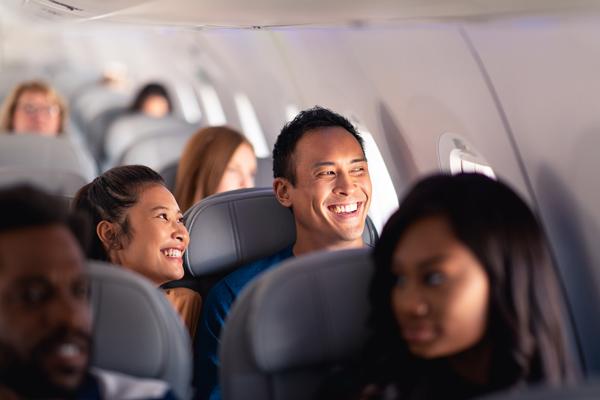Creating The Right Environment To Fly

It’s no wonder people are hesitant to get back on airplanes. They’re constantly bombarded with images of flight attendants dressed in hazmat suits, cabins filled with anxious-looking masked passengers, airport disinfecting chambers, and odd plexiglass seat shrouds that allegedly contain airborne bio-contaminants.
The rationale for keeping the same safe distance on an airplane as you would on the ground is understandable. But selling only half or two-thirds of available seats doesn’t make for good economics. Ticket prices would need to rise to cover operating costs.
We don’t believe selling fewer available seats and raising ticket prices is the right solution, especially when there are initiatives that ensure passenger safety and aircraft sanitation already in effect.
Cabin Surfaces
The most common droplets that people expel by talking, coughing, and sneezing are between 4 and 8 microns in size. The heavier ones fall close by and land on surfaces - entertainment screens, fabrics, PSUs, armrests, tray tables, bins and wall panels. Airlines have implemented rigorous deep-cleaning procedures that sanitize surfaces where contaminants collect. The new measures are impressive and extremely effective.
Cabin Air
Passengers may be more at ease if they knew that cabin air circulation and ventilation are carefully engineered to disperse and re-direct the smaller droplets that can remain suspended. HEPA filters trap over 99.9% of airborne particles and other bio-contaminants as small as 0.3 microns. Moreover, an aircraft exchanges its entire volume of cabin air 20 to 30 times more frequently than the air in an office, and 5 to 6 times more than hospitals. The air in an E-Jet cabin is completely refreshed at least 20 times every hour. The air circulates through strategically placed vents and upper and lower air inlets around the overhead bins.
Engineered for Safety
We conducted a series of CFD (Computational Fluid Dynamics) tests and simulations of cabin air flow years ago during development of our E-Jets. Our objective was to ensure that airborne contaminants were effectively directed away from passengers by minimizing the number of axial flow components. In other words, droplets are dispersed vertically and channelled away from other passengers as much as possible.
We found that the airflow resulting from correct positioning of the PSU air outlets in relation to a person’s head creates a kind of air curtain, or air barrier. The cone-shaped flow pattern from the gasper directs particles to air return grills located near the cabin floor. This minimizes cross-contamination between rows although the seat banks themselves serve as natural blocks to exhaled droplets. Forward-facing seats also minimize direct face-to-face passenger interaction.
Restoring Confidence
Most carriers now either require or recommend that crew and passengers wear face masks. They’re also restricting cabin movements, such as trolley service, that disturb air flow and could spread airborne particles. Yet the risk of infection on an airplane remains extremely low. During the SARS outbreak in 2003 when these additional hygiene measures weren’t in place, there were no recorded cases of viral transmission between passengers.
Even with all these safeguards for aircraft sanitation, the key to restoring consumer confidence and ensuring the in-flight health of everyone lies with new technology at airports. And that new technology may already be here. Airlines, namely Etihad, and airports, like Hong Kong, Dubai, and Abu Dhabi, are now prototyping disinfecting devices and health tests.
Determining a passenger’s fitness to travel before approaching the check-in counter makes for the safest, most profitable flight of all.





Comments